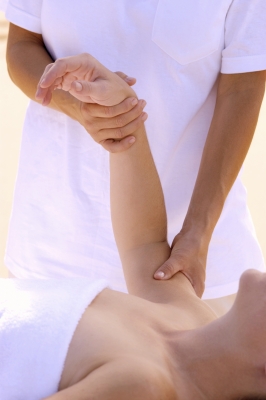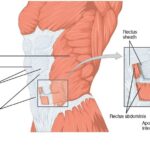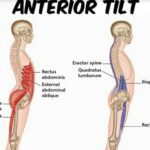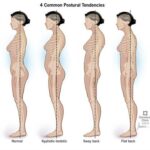Massage is a part of many professional athletes’ lives. Nowadays, even amateur sportspersons have access to certified sports massage therapists who offer their services in fitness centers, gymnasiums, and events such as marathons. This allows everyone to include massage in their fitness and wellness regimen. Indeed, exercising regularly increases the amount of Lactic Acid in muscles, creates muscle soreness, swelling, stiffness and fatigue, all of which can promote injury. Before injuries occur, having massages helps the muscles recover faster, be more flexible and less fatigued, through techniques such as stretching, PNF, Swedish and Deep tissue. Overall, Massage Therapy helps improve performance and prevent injuries for all those interested in working out.
1. The side-effects of exercising and how massage counteracts them

Exercising is a necessary and beneficial part of a healthy lifestyle; but working out regularly can have some negative side-effects that slow down one’s efforts and promote injury if not tended to. Historically, athletes have used massage therapy to counteract these negative side-effects, and today, scientific research confirms that massage is effective. Even though the experiment of the University of Tennessee (High et al., 1989) concludes that pre-workout massages and stretching have no relieving effect on training pains, during or post-workout massages have measurable positive effects on performance: they facilitate muscle drainage and circulation, decrease muscle soreness and swelling, improve relaxation and range of motion, and decrease fatigue.
1.1 Lactic Acid builds up in muscles and massage facilitate its drainage
The accumulation of Lactic Acid in the muscles is a consequence of chemical reactions, necessary to fuel the muscles; massage facilitates its drainage. The Atlas de poche de Physiologie explains that ATP is the energy source for muscles: it is created, in part, directly in the muscle, through a series of chemical reactions that use Creatine Kinase, Glucose, Fatty acids and Oxygen as reactants. The products are ATP but also Carbonate Dioxide, Lactates and Hydrogen, the 2 latter combining to form the infamous Lactic Acid (Silbernagl, Despopoulos, 2004). However, Lactate isn’t bad: Brooks (1986) states that 20% of the Lactate produced in the muscle is converted to Glucose that can be reused in the muscle to create ATP, and the 80% remaining are transported to the heart and liver where it is converted to Glucose for these other organs’ use. Consequently, Lactate is removed from the muscle quickly after a workout, and a massage isn’t necessary to push it out of them, as the Neuromuscular Research Laboratory of Pittsburg, PA has found in a study (Martin et al., 1998). Nevertheless, massage holds an indirect role in the muscle drainage of toxins and circulation: by promoting muscle relaxation and decrease in tonicity, the muscle can perform its own drainage better than if it stays in a state of contraction and hypertonicity (Vanderbilt, 2001).
1.2 Muscle soreness and muscle swelling are decreased by massage therapy
The vilified Lactate was also thought to be responsible for the muscle soreness felt days after exercising. But it isn’t the case: the lasting pain is caused by micro-traumatism in the muscle; having post-workout massages help decrease it. The muscle soreness, or DOMS (Delayed-Onset Muscle Soreness), is the pain that usually starts after 24 hours and decreases after 72 hours, in muscles that have been solicited during a new or a longer exercise than they are accustomed to. In his book, Skeletal muscle damage and repair, Tiidus (2008) says it corresponds to micro-traumatisms such as micro-tears of muscle fibers and connective tissue. DOMS can be accompanied by muscle swelling due to the inflammation that surrounds micro-traumatisms. A research experiment by Zainuddin and colleagues (2005), involving the repetition of elbow flexions, showed that the muscles that were massaged after the repetitions had less muscle soreness and presented decreased swelling. Other research by Hilbert and his colleagues (Hilbert et al., 2003), involving a series of hamstrings contractions, have yielded the same conclusions: post-workout massages decrease DOMS and muscle swelling, helping athletes recover faster and with less pain.
1.3 Muscle stiffness and inflexibility are improved by massages and stretching
Along with muscle soreness and swelling, another possible manifestation of training is post-workout stiffness: massage therapy and stretching help diminish this muscle hypertonicity and increase muscle flexibility. According to the works of Jones et al. (1987), stiffness corresponds to the “shortening of non-contractile elements” and can result in the apparition of “knots” inside the muscle. Thebodyworker.com explains that these “knots”, also called trigger points, are a cause of pain during movement and stretching, which results in a decrease in the range of motion. Moreover, they are tender when direct pressure is applied: the pain can be on the spot or in a referred area of the body (Trigger point therapy definitions). Around the muscle, hypertonicity has an effect on joints, that are put under stress by those pulling muscles, and arteries and veins that are compressed by the shortened muscles. During a massage therapy session, a lighter massage stimulates muscle relaxation, as Morelli and his team studied in their research (Morelli et al., 1990), while a deep massage helps loosen “knots”. Moreover, stretching techniques also participate in muscle relaxation and trigger point release, while they elongate shortened muscles.
1.4 Fatigue is decreased after a massage
Lastly, and quite simply, fatigue occurs during the workout or afterwards; fatigue is decreased by post-workout massages. The Atlasde poche de physiologie divides fatigue in two kinds. There is a peripheral fatigue, which happens when the muscles themselves are tired because they are running out of resources to create ATP. Measurements done by Ogai et al. (2008) during intensive cycle pedaling have shown that post-workout massages provoke a marked decrease in muscle fatigue. There is also a central fatigue. This affects the whole body, and the psyche. When exercise is intense, muscles are sore, joints too, the whole body and mind aches and there is a decrease in the motivation to continue (Silbernagl, Despopoulos, 2004). The general relaxing and mood enhancing effects of massage are a way for the athlete to regain motivation and energy to continue his/her training. Both peripheric and central fatigue are decreased by massage, which means that it is possible for the athlete to do more and better workouts, which, ultimately, will help improve performance.
2. The sports massage techniques
The sports massage techniques, that counteract training side-effects and help prevent injury, are varied: they combine, among other methods, stretching, PNF (Proprioceptive neuromuscular facilitation), Swedish massage and Deep tissue massage. The techniques are determined by the Massage Therapist according to the needs and tolerance of the athlete: each massage is unique to the therapist, the athlete, and the particular session.
2.1 Stretching and PNF (Proprioceptive Neuromuscular Facilitation)
Stretching is a good way to start a sports massage session, as it elongates, relaxes and warms up the muscles. The massage therapist knows which position allows for the maximum elongation of a muscle according to its position and physiology. In this position, the therapist ensures that the stretch is localized by making sure no other joints than the one involved in the stretch move: this can be done by holding down body parts or by putting the athlete in a position that will not allow compensatory movements. The therapist is positioned to have a good lever and to use his/her body weight against the shortened muscle: that way, he/she is always stronger than the stiff muscles and doesn’t get tired. According to massage therapist Laura Allen (2010), PNF can be used to increase flexibility: “a muscle is stretched into resistance and then held for 10 seconds, followed by the client holding a [static] contraction for 5 seconds, and repeating the process several times” , until the maximum stretch position doesn’t move anymore. This is great for a deep and visible stretch

2.2 Swedish massage
After stretching, a few Swedish massage techniques are a good way to continue warming up and relaxing the muscles. After applying some oil or lotion on his hands, the therapist does effleurage, which is a gliding stroke. Petrissage, or kneading, can follow, which is pulling the muscle away from the bone and rolling it like cooking dough. If the therapist finds a knot, he can stay on that spot and create friction circular movements that are more localized. Friction can also be perpendicular to the muscle fibers, which is called cross-friction. Tapotement stimulates blood flow by tapping the muscle rapidly, alternating both hands, with the side of the hand.
2.3 Deep tissue massage
Once the muscles are warmed up, the therapist can go deeper, on the whole muscle or on the specific trigger points found on an individual. The principal of these techniques is the same: longitudinal strokes, cross-friction strokes and circular strokes, but the therapist goes much deeper to get to the deep muscle fibers of the superficial muscles or to get to the deeper layers of muscles. To do so, the therapist uses his/her thumbs, forearms and elbows assisted by his/her body weight. The pressure is as hard as the muscle can take without creating pain. Both the athlete and the massage therapist determine the level of comfort tolerable for the deep massage.
Exercising regularly and intensely is great for the body, but it has negative side-effects such as the creation of lactic acid, DOMS, swelling, muscle stiffness, decrease in range of motion, as well as prolonged fatigue, that can lead to injury if left untreated. Research has shown that massage helps the muscle drain their toxins, decrease muscle soreness and swelling, increase muscle relaxation and flexibility, and decrease fatigue. The sports massage techniques vary, and include stretching, PNF, Swedish massage and Deep tissue massage. These allow the athlete to recover faster in-between or during workouts, to prevent sports-related injuries, and to improve his/her general well-being.
References :
- Allen, L. (2010). Plain and simple guide to therapeutic massage and bodywork examinations. Lippincott Williams & Wilkins, Wolters Kluwer Health.
- Brooks, G.A. (1986). The lactate shuttle during exercise and recovery. Med Sci Sports Exerc. 1986 Jun;18(3):360-8.. (http://www.ncbi.nlm.nih.gov/pubmed/3523107 consulted on 08/10/10)
- High, D.M., Howley, E.T., Franks, B.D. (1986). The effects of static stretching and warm-up on prevention of delayed-onset muscle soreness. Res Q Exerc Sport. 1989 Dec;60(4):357-61.(http://www.ncbi.nlm.nih.gov/pubmed/2489863 consulted on 08/10/10)
- Hilbert, J.E., Sforzo, G.A., Swensen, T. (2003). The effects of massage on delayed onset muscle soreness. Br J Sports Med 2003;37:72-75 doi:10.1136/bjsm.37.1.72 (http://bjsm.bmj.com/content/37/1/72.fullconsulted on 08/11/10)
- Jones, D.A., Newham, D.J., Clarkson, P.M. (1987) Skeletal muscle stiffness and pain following eccentric exercise of the elbow flexors. Pain. 1987 Aug;30(2):233-42. (http://www.ncbi.nlm.nih.gov/pubmed/3670875 consulted on 08/10/10)
- Morelli, M., Seaborne, D.E., Sullivan, J. (1990) Changes in H-reflex amplitude during massage of triceps surae in healthy subjects. J Orthop Sports Phys Ther 1990;12:55–59. (http://www.ncbi.nlm.nih.gov/pubmed/18787257 consulted on 08/10/10)
- Ogai, R., Yamane, M., Matsumoto, T., Kosaka, M. (2008). Effects of petrissage massage on fatigue and exercise performance following intensive cycle pedaling. Br J Sports Med. 2008 Apr 2 (http://www.ncbi.nlm.nih.gov/pubmed/18385196 consulted on 08/10/10)
- Silbernagl, S.-Despopoulos, A. (2004). Atlas de poche de physiologie. Medecine-Sciences, Flammarion.
- Tiidus, P. (2008). Skeletal muscle damage and repair. Human kinetics. (http://books.google.com/books?id=ueMh1x7kFjsC&pg=PA59#v=onepage&q&f=true consulted on 08/10/10)
- Trigger point therapy definitions (http://www.thebodyworker.com/triggerpointdefinitions.html consulted on 08/10/10)
- Vanderbilt, S. (2001). Sports Massage and Recovery Time, Re-examining the role of lactic acid. Massage & Bodywork magazine, October/November 2001. (http://www.massagetherapy.com/articles/index.php/article_id/541/Sports-Massage–Recovery-Timeconsulted on 08/10/10)
- Zainuddin, Z., Newton, M., Sacco, P., Nosaka, K. (2005). Effects of massage on delayed-onset muscle soreness, swelling, and recovery of muscle function. J Athl Train. 2005 Jul-Sep;40(3):174-80. (http://www.ncbi.nlm.nih.gov/pmc/articles/PMC1250256/ consulted on 08/10/10)
- Martin, N.A., Zoeller, R.F., Robertson, R.J., Lephart, S.M., (1998). The Comparative Effects of Sports Massage, Active Recovery, and Rest in Promoting Blood Lactate Clearance After Supramaximal Leg Exercise. J Athl Train. 1998 Jan–Mar; 33(1): 30-35 (http://www.ncbi.nlm.nih.gov/pmc/articles/PMC1320372/ consulted on 08/11/10)
This article and/or video are for educational purposes only; do not attempt without your physician’s clearance. If you are in pain or injured, see your physician.
Copyright © Vidal Sports LLC 2018







